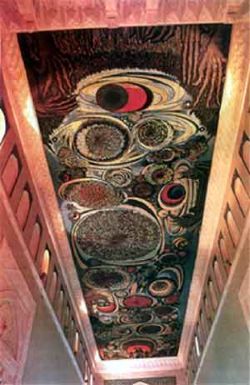 Lahore Museum’s glorious edifice stands on Shahrah-e-Quaid-e-Azam, also known as The Mall Road, opposite to 100-year old Allama Iqbal Campus of the Punjab University. Blended with the elements of old tradition of Mughal architecture, the Museum is conspicuous among all the structures build during the British period on Shahrah-e-Quaid-e-Azam. Founded by Prince Albert Victor, The Prince of Wales, and opened for public in 1894, it is in fact Pakistan’s largest museum and holds the country’s richest cultural and historical materials.
Lahore Museum’s glorious edifice stands on Shahrah-e-Quaid-e-Azam, also known as The Mall Road, opposite to 100-year old Allama Iqbal Campus of the Punjab University. Blended with the elements of old tradition of Mughal architecture, the Museum is conspicuous among all the structures build during the British period on Shahrah-e-Quaid-e-Azam. Founded by Prince Albert Victor, The Prince of Wales, and opened for public in 1894, it is in fact Pakistan’s largest museum and holds the country’s richest cultural and historical materials.
Lahore Museum has many galleries and one of the most famous one is the Central Miniature Painting Gallery. As we enter the Miniature Paintings Gallery of Lahore Museum and lift our head up, we can observe the mural painted on the ceiling by one of the most gifted painters of Pakistan, Sadequain Naqqash (Syed Sadequain Ahmed Naqvi: 1930-1987). A mural is a very large image, such as a painting or enlarged photograph, applied directly to a wall or ceiling.
According to Answers.com:
The roots of art of murals can be found in the universal desire that led prehistoric peoples to create cave paintings — the desire to decorate their surroundings and express their ideas and beliefs. The Romans produced large numbers of murals in Pompeii and Ostia, but mural painting (not synonymous with fresco) reached its highest degree of creative achievement in Europe with the work of such Renaissance masters as Masaccio, Fra Angelico, Leonardo da Vinci, Michelangelo, and Raphael. In the 20th century, the mural was embraced by artists of the Cubist and Fauve movements in Paris, revolutionary painters in Mexico (e.g., Diego Rivera, José Clemente Orozco, David Alfaro Siqueiros), and Depression-era artists under the sponsorship of the U.S. government (e.g., Ben Shahn, Thomas Hart Benton).
The people of Pakistan were introduced to the art of murals by Sadequain. Lahore Museum’s ceiling, painted in 1973, is based on poet Allama Iqbal’s idea of ‘Khudi’ or ‘Self’, evoking the spirit of man to triumph over odds. It depicts man’s search for knowledge and ultimate triumph. Unlike most of Sadequain’s paintings and drawings which are full of angst, melancholy subjects and negation of his personal self in the tradition of the ‘fakeer’ show man at his most decadent and hypocritical, his murals always reflect optimism. Its interesting to note that Sadequain sold very few paintings in his life and most of his work was public.
Sadequain painted the ceiling of Lahore Museum in 1973, living and working in the building for six months. As Niilofur Farrukh writes in DAWN:
The mammoth painted ceiling of the Central Gallery at the Lahore Museum takes its inspiration from Iqbal’s verse ‘Sitaroon say agay jehan aur bhi hein, abhi ishq kay imtihan aur bhi hein’ (there are many worlds beyond the stars and many challenges yet to be met), the artist puts Adam and Eve on the centre stage and challenges them to harness the untapped energy of the universe. Curled in a cocoon like embryos the male and female figures seem to anticipate the moment of awakening. The panorama that surrounds them is a tightly knit constellation of stars and planets in motion. The large discs are depicted as a kinetic mass with halos that open up in a spiral of waves. This timeless process of destruction and construction in the skies, with large meteors spewing debris in their wake to herald the birth of new planets is shown against the dense black space of infinite galaxies. This allegorical references point both to the vast resources available to man and the constraints of time put on him to complete the mandate.
Another one of his early mural of mid 60s called Saga of Labor, based on the dignity of labor is housed in the Turbine room of Mangla Dam. ‘Saga of Labor’ is probably the largest mural in Pakistan.
“Saga of Labor†– Portion of the Mural at Mangla Dam – largest mural in Pakistan 200 ft x 70 ft
The other famous murals of Sadequain include The Treasures of the Times – A mural for the State Bank in Karachi (100 x 12 ft) in 1961, a mural at Karachi’s Jinnah Hospital, Aligarh Muslim University (70 x 12 ft), Banaras Hindu University (70 x 12 ft), Geological Institute of India (70 x 25 ft). Then there are murals like War and Peace, Darkness and Light which can be viewed here. Click here for a very interesting slide show of Sadequain’s murals.
The mural below was painted by Sadequain in 1968 for Punjab University’s library.
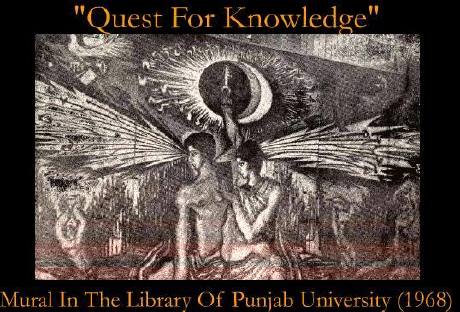
One of the old Karachi Airport manager, Mr S. Hassan Shamsie, purchased several paintings of Sadequain in the mid and late 50s. These paintings were hung on the pillars of the foreign departure lounge. The most significant of them was a 1957 mural (40 ft long) on display on the railing of the departure hall of the old airport. All these murals and paintings remained there till the 80s. They are now in the house of a former DG Civil Aviation Authority in Islamabad. This mural and the paintings are public property and must be returned to the Karachi Airport.
I couldn’t find more details about Jinnah Hospital and old Karachi Airport murals so it would be great if any of the readers can tell us more about them, with images preferably. There is another mural by Sadequain in Paris at the PIA office at Champs Elysee. It was then PIA Chairman, Air Marshall Asghar Khan’s idea who felt that a PIA office in Paris needed to show off Pakistan’s greatest painter. There is another one in Lausanne at the Swiss Fair foreign commissions. I don’t have much details on that. Share with us if you know of any other mural by Sadequain.
Sadly, while working on his second ceiling at the Freer Hall in Karachi (above), the painter took ill and died leaving the work incomplete. Freer Hall was later named as Sadequain Gallery. I am not sure if there are many artists in Pakistan today, following the foot steps of Sadequain and keeping the art of murals alive in Pakistan. I only know of one young sculpture Jabbar Gul whose mural is placed in the entrance of Learning Resource Building of the State Bank. It documents the history of the Bank through the varieties of coins issued since independence.
Note: Most of the images have been taken from the book The Holy Sinner, Sadequain and for the rest of the images, links have been provided in the post. Click for enlarged view. A short version of this post was also published at Metroblogging Lahore in 2005.
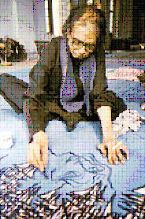

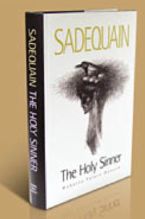
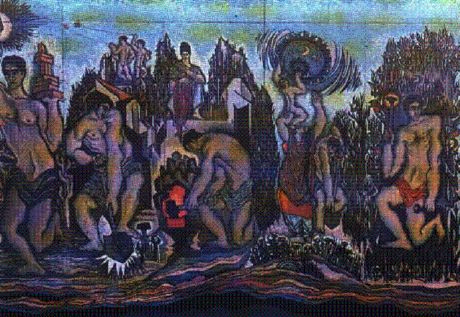
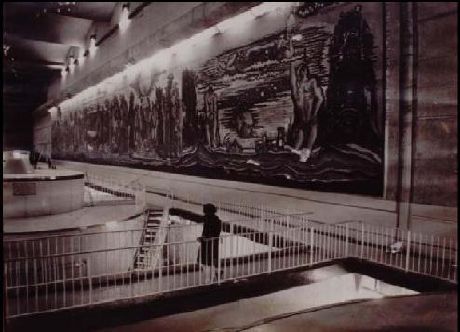
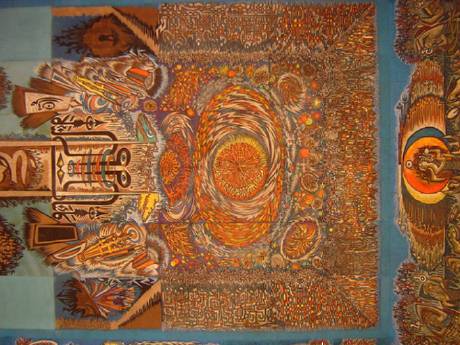



















































His monumental murals, in excess of thirty-five, represent unparalleled body of artistic endeavor by any artist of the country. These murals adorn the halls of State Bank, Frere Hall Karachi, Lahore Museum, Punjab University, Mangla Dam, Aligarh Muslim University, Banaras Hindu University, Indian Institute of Geological Sciences, Islamic Institute in Delhi, and Abu Dhabi Power House to name a few. To put it in perspective, his paintings and calligraphies in the building of Islamic Institute in Delhi alone cover more than seven thousand square feet.
Sadequain painted his earliest murals at Jinnah Hospital and PIA head quarters in 1950s. These murals have disappeared and their fate is unknown.
In 1961 he painted the huge mural (62’X10′) in the Head Office of the State Bank of Pakistan at Karachi, titled “Treasures of Time,
I have never seen “Quest for Knowledge” in PU but I will definitely go and check it out.
Thank you for wonderful post and very informative comments. This website is amazing.
my pleasur to see ur website
-fine artist maroofakhan ,curator arts council of pakistan
my name is fidahussain changazi 27 male from quetta pakistan i m fine artist mein ney balochistan councile kalam khaan sey kaam sikaa merey nass nass mein art hein muji shok ta kaam karney ka but halaath ney muji artist too banadiya magher degree nahe hein merey pass jaib mein saqain ko ki kaam ko deik ta hoon tooo muji sahe maano mein asain style nazar aata hein mein impress hoon ithney badey usstaad sey salam hein ess azeem usstad ko sadaiqain usstad ney fan ki koye intiha nahe artist hein tooo sadiqain ess ki kaam ki koye saani nahe duss koye saqain nahe aaye ga agher fan ki bat karye puri dunya mein sadaqin jahsey inssan nahe mily ga nahe aaye ga agher aaj agher zinda hota mein uss ki kadmo ko choom ta uss kay haat ko choom ta mein ney vist kya hein saqain art gallary ko mein mind deil sey nahe apney meain sey un kay kaam ko deik ta hoon saqin ney mashriq e art ko permot ki hein aagher aaj mashriqi art hein sadaqain kay dam sey merey duwa hein sub ko allah kamiyab karye merey sub artist sey request hein kay ki c artist ko ki c artist sey compairr nahe karna q kay sub apni apni jagah pay important koye ki c sey zayada nahe khuda jaan hein kon acha ….
In the TV programme “Takra” didar parvez Bhtti so Many Q to Sadequain and sudunly Sadequain show of Hand we see the hand and camera also show close up of Sadequain hand then I realize the finges of Sadequain look like Allah Name.the TV programme in B/W.
He is Great Man, I am syed Tahir Abbas Rizvi I am calligraphy Painting artist so many time in the day think Sadequain.
I am working after the high imagine in paint word (Haroof) in small & big scale. I have my own style that I just finished calligraphy Painting two weeks ago and I am eager to use it as well as other outstanding work. Please recommend anyone who you think is like calligraphy Painting. I need people to see my work. I have a relationship with local galleries that would like to see my work and the said plan solo exhibitition.Take a moment to check out examples of my work at http://www.namwar.com